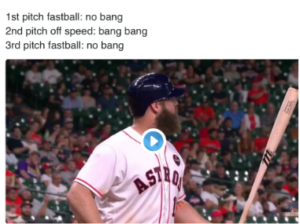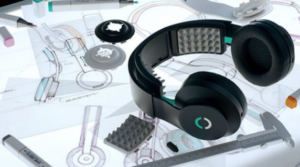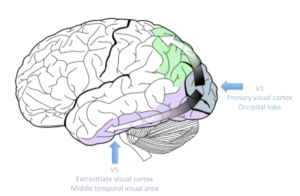
Abnormal banging could be heard from the Astros’ dugout based on different speed pitches during the 2017 World Series.
Why They Did It, How It Worked, and What’s Next…
We’ve recently learned that the Houston Astros sign-stole pitches, using a program dubbed “Codebreaker”. Interestingly, the Wall Street Journal just published it was an intern who developed the Excel-based scheme used through 2017 and part of the 2018 seasons. The role in 2019 may be unclear. However, it likely aided in the 2017 World Series win.

Game 6 of the 2019 ALCS Jose Altuve shockingly hit a walk-off home run off Aroldis Chapman, whose fastball is often “unhittable” Altuve seemed to not want his jersey yanked off… which is an accustomed celebration Altuve responded to on-field reporters that he’s just “shy”
The Astros reportedly would log the opposing catcher’s signs and subsequent pitches in an Excel spreadsheet, and the “Codebreaker” program determined the relationship. During games, the information would be communicated to the hitter by either: 1) members of the dugout banging on a trash can, or 2) tactile electrode signals attached to the player’s body (MBL recently, “explored wearable devices during the investigation but found no evidence to substantiate it”.)
Many would ask, why would the Astros do this? Well… neuroscience tells us… it’s pretty darn hard to hit a round baseball… moving 80-100 mph… squarely… using a round bat! It would be much easier to have more time and information to process the pitch.
Neuroscientists have found that the human brain can analyze entire images in as little as 0.013 seconds. After visual input hits the retina, the information flows into the brain where shape, color, and orientation are processed in the occipital lobe. However, to respond to that stimuli, it may take at least another 0.3 seconds for the brain to make an extremity’s muscle move.
A fastball, around 90 mph, takes about 0.4 seconds to reach home plate.

When the neuroscientists at MIT recorded the 0.013 processing speed, they were showing static images on a computer for which the participants needed to identify it about 50% of the time. More accurate processing takes about 0.1 seconds. Furthermore, the baseball batter is processing a moving object, and needs to calculate its end location more precisely, which takes a little more time. Evolutionarily, this is advantageous. We can’t react to a moving object at a static location, because by the time it’s processed, it’s now somewhere else. Everything our brain receives is already out of date by the time it reaches the brain. None of us see the world as it really is… we just see a calculation. For example, based on a 100-millisecond holdup, a baseball moving at 90-100 mph would have already advanced about 10 feet before the brain could register its original location. Thankfully, the brain “pushes forward” moving objects so we perceive them as further along in their trajectory than the eye really sees. There’s a special area of the brain that does this, called the V5 region in the middle temporal gyrus. This is a completely separate region from the occipital lobe, which contains the primary visual cortex (V1), where static images are analyzed.
If batters relied on the V1 primary visual cortex to process a pitch, they would be seeing the ball about 3-4 yards behind where is actually is.
In summary, even using the V5 extrastriatal cortex, the batter has no spare time if they guessed at the pitch or got an early look at the spin. They need 0.1 seconds to process and 0.3 seconds to swing at a ball crossing home plate, 0.4 seconds after it left the pitcher’s hand. This doesn’t provide great odds for the batter. This is why a good batting average is simply above .300 in MLB… the batter is only successfully hitting 1 out of 3 times. Would you go to a neurosurgeon who had only 1 successful surgery every 3 times he operated?
So how do batters get an edge at the pitch type?
For one, recordkeeping is a premise to baseball. Using the wonders of technology, the balls/ strikes thrown in different scenarios have been calculated over years of data using something called, Markov chains. This data can be provided to the batter to estimate pitches thrown historically in certain counts by a specific pitcher. (This was the premise of “Moneyball”).
Even simpler, there are certain strike counts where any pitcher is more likely to throw a strike or a certain type of pitch. For example, in a 3-0 count, a pitcher throws a fastball strike 94% of the time. Accordingly, the MLB average for a 3-0 count is .407. In contrast, a 0-2 count could present just about anything, and as such the MLB average is .157. Even a 3-2 count is very unpredictable, demonstrated by the .211 MLB average.
The Astros’ “Codebreaker” takes advantage of the brain’s other sensory systems to predict pitches.
 What is the fastest sense? Most people would say vision, since light travels faster than sound. When a sonic boom occurs, we see the plane move before we hear the “boom”.
What is the fastest sense? Most people would say vision, since light travels faster than sound. When a sonic boom occurs, we see the plane move before we hear the “boom”.
However, that has absolutely nothing to do with hearing. It doesn’t matter that sound moves slower than light… the fact is that info gets from ear-to-brain, faster than eye-to- brain. While accurate visual motion processing takes about 0.1 seconds, your brain can recognize distinct sound in 0.05 seconds. That’s two times faster than the blink of an eye. Hearing a trash can pounding could be processed by the Astros’ batters faster than they could even see the pitch.
What other sensory modality is quickly processed? Touch. It takes about 0.2 seconds for the brain to recognize something touching a hand or foot in the somatosensory cortex. But certain areas of our body can discriminate touch better. Our fingertips can discretely perceive different touches only 2 millimeters apart. Our fingertips are about the most sensitive areas of our body, however, the Astros’ players couldn’t have buzzers on their fingers since this would be visible and interfere with holding the bat. The breast and belly region are the most sensitive areas to detect two-point discrimination amongst regions covered by a baseball jersey. Electrodes about 3 centimeters apart could easily perceive impulses sent from the Astros’ bench to notify the upcoming pitch. (Again, wearable buzzing devices have been implicated, but not proven by MLB.)
 So by using sound signals, and debatably two-point discriminating buzzers, the Astros’ batters had an early sense of the upcoming pitches before it was even thrown. This information, along with trained eyes and stats prepopulated in their prefrontal cortices gave them the upper hand.
So by using sound signals, and debatably two-point discriminating buzzers, the Astros’ batters had an early sense of the upcoming pitches before it was even thrown. This information, along with trained eyes and stats prepopulated in their prefrontal cortices gave them the upper hand.
The Astros, as a team, may have been predictable culprits of neuroscience-based baseball shenanigans.
The Astros have been one of the earliest teams to use wearable baseball technology. They reportedly have been experimenting with Halo Neuroscience, which applies transcutaneous electric impulses to the motor cortex via a headphone-looking device. Pregame, they look like they’re listening to a little music, but they’re really zapping their neurons. This device theoretically accelerates the brain’s neuroplasticity to improve connections between the brain and muscles. This may help athletes gain strength, skill, and endurance faster.
The Astros are also using soft tissue technology to monitor a variety of biometrics, including heart rate, respiration, muscle exertion, and muscle GPS. These wearables are designed to be as unobtrusive as possible and look much like regular compression clothes, in the form of compression shirts, tank tops, and shorts. There are even monitors fitting in shoes. MLB is aware of much of this technology and is considering approving some use in the future. In the training setting, it’s not just the Astros and not just MLB experimenting with wearable technology.
The application of neuroscience to athletic training is readily expanding. Its investment is projected to reach more than $31 billion by 2023. However, there’s a huge difference between optimizing athlete training and frank in-game cheating. It represents a bold, complex new field, and carries ethical concerns.








